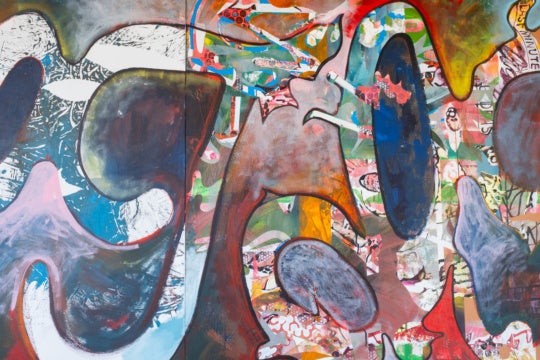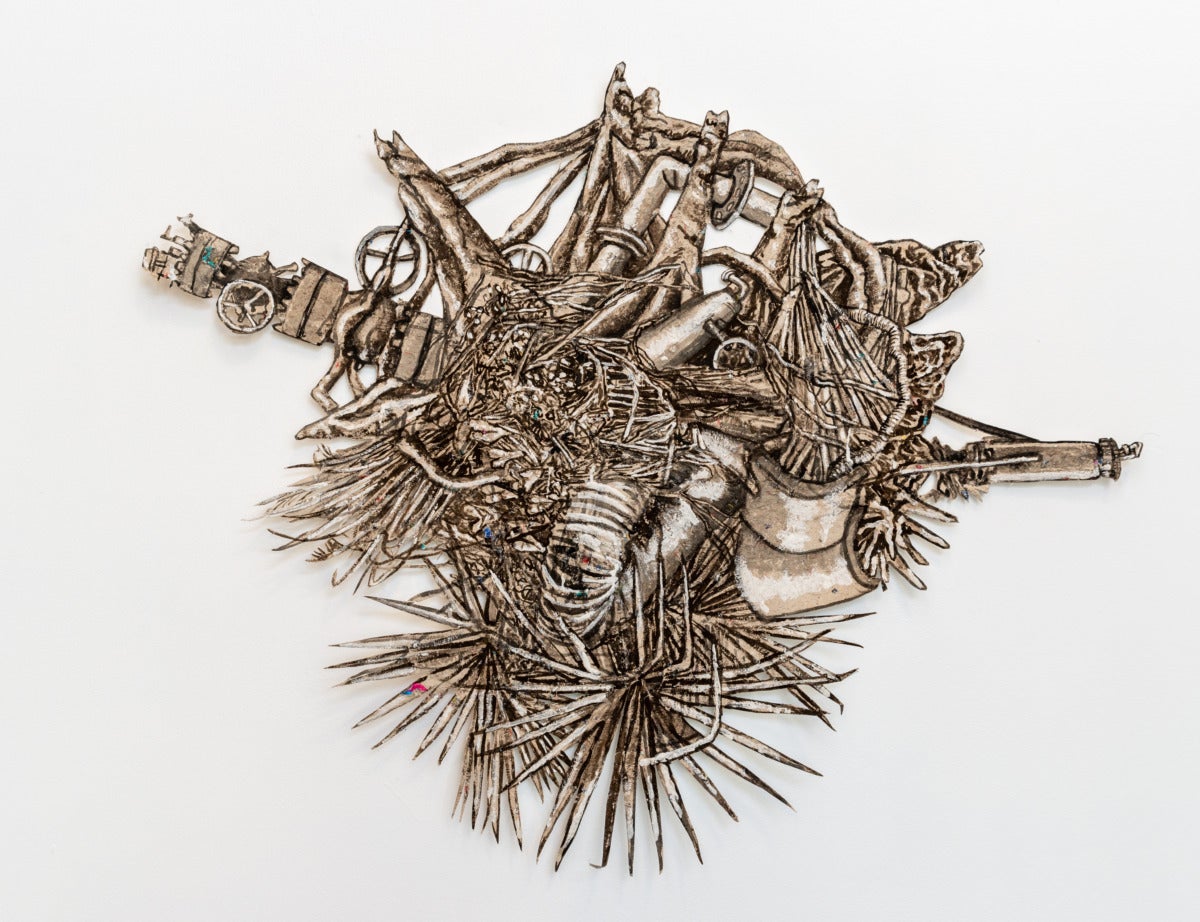
Perched on a crooked base of repurposed drainage pipes, Hannah Chalew’s Floatante (2020) is configured around a pair of spherical planters formed of a pigmented mixture of sugarcane and lime. Recently on view at The FRONT gallery in New Orleans, the sculpture comprises a tangled assemblage of objects embedded in and protruding from the pulp: plastic netting from a bag of oranges, computer parts, a bag of chips, metal wires and grocery bags, as well as soil that nourishes living plants. These are watered through a snaking network of pipes formed of “plasticane”—the artist’s term for a handmade pulp mixed from shredded plastic and a sugarcane byproduct called bagasse–pipes lined with irrigation tubing, such that Floatante becomes a fully-functional ecosystem, formed of fibers and trash, earth and steel.
Like the other works on view in Chalew’s focused exhibition Structural Trap, curated by artist Sara Madandar, Floatante represents a kind of futurist proposition: The artist invites us to imagine a landscape ravaged by coastal decay, pollution, and civilization ruins. How might such an environment evolve without us? What will happen to this place if we fail to change course? Appropriately, Floatante is titled after a buoyant plant species found in marshlands and swamps; rather than being rooted in place, it drifts along the water’s surface, and can withstand flood events by simply rising and falling with the tides—the work is an evocative suggestion of a nomadic state, prompted by intensifying climate disasters.
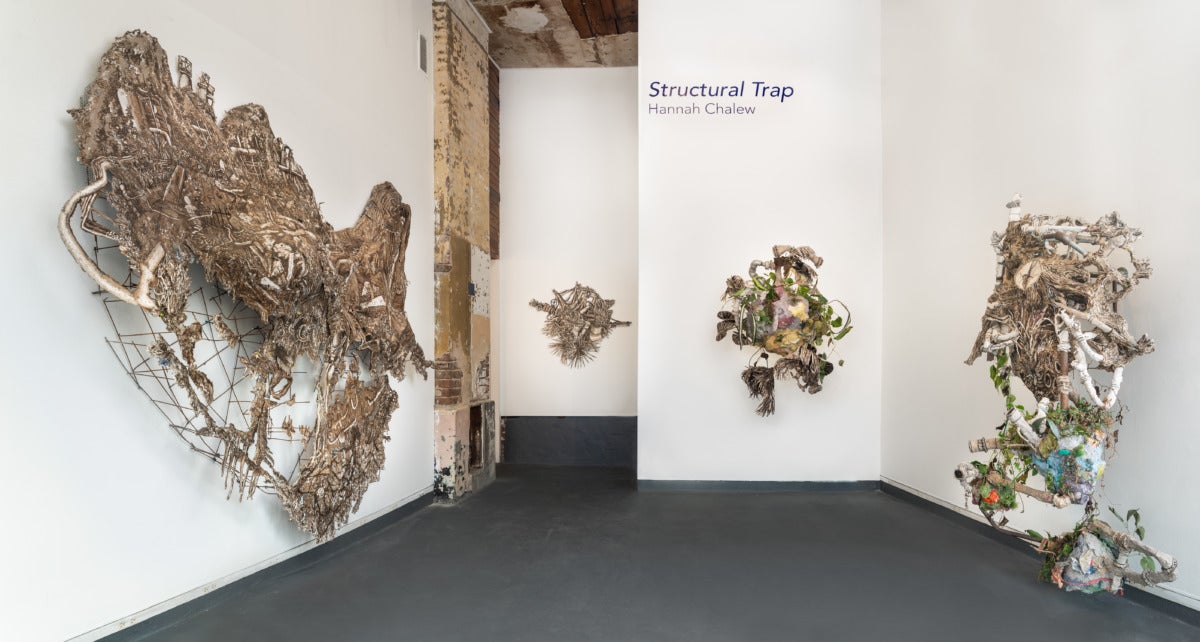
The exhibition includes two- and three-dimensional “drawings” produced from materials that are symbolically, ecologically, and historically potent. Drawn details of drainage pipes and root systems are rendered using handmade inks derived from oak galls and shells, as well as industrial run-off. Chalew’s signature “Plasticane,” which forms both bones and binder of her sculptures, is made from a combination of sugarcane fibers, household trash, and litter collected from the streets of New Orleans. Sugarcane, of course, was one of the major cash crops produced through chattel slavery, and accounts for centuries of racialized violence and wealth stolen through forced, conscripted labor. While hundreds of plantations once lined the Mississippi River between New Orleans and Baton Rouge, this stretch of land is now referred to as the state’s “chemical corridor” or “Cancer Alley”, as it is populated by petrochemical refineries that manufacture single-use plastics like the detritus Chalew “recycles” into her art. The artist is deeply attuned to these connections between Louisiana’s past and present—to the “capitalist, settler colonialist roots,” as she puts it, of contemporary environmental injustice.
Chalew’s work challenges these paradigms on visual terms, as well, subverting traditional forms of landscape representation linked to the codification of private property. In Western art history, landscape painting emerged alongside modern conceptualizations of land ownership and colonial territory. Usually, viewers are treated to satisfying “prospect views” of rolling hills and manicured lawns that neatly unfold before our privileged eye. Chalew’s drawings completely destabilize this pictorial logic, moving from birds-eye views and frontal elevations to subterranean root systems, towering skylines, and explosive sprays of palmettos and pipes. The titular Structural Trap (2021), for instance, is bolted to the wall at eye level, where we are confronted by a blasted tree-trunk seen from above; a cluster of pipes, plants, and detritus rains down toward the floor. Petroplexus (2019), a drawing that is wall-mounted on a grid of rebar, is shaped like an irregular land mass, and shatters into an archipelago of fragments at its edges—in disconcerting resemblance to Louisiana’s disintegrating coast.
Together, Chalew’s works articulate the stakes of our society’s toxic treatment of biological and social ecosystems, insisting that we imagine, and avoid, the dystopian environmental future that lies ahead.
Allison Young: I thought we should begin with the title of the exhibition, “Structural Trap.” Can you say a bit about this term and its various associations for you?
Hannah Chalew: Yes! As part of my research, I often find myself looking up engineering and oil industry terminology. I recently came across “structural trap”—the term for a geological fault that creates a pocket of some natural resource, usually petroleum or a natural gas. This really resonated with me in terms of the particular situation that we’re in, in Southern Louisiana, where our culture and economy are so inextricably linked to the oil and gas industries. We’re also so vulnerable and precariously located on the frontlines of the damages they cause. We see it, and yet it’s impossible to get out of this morass. I thought the term was perfect – it speaks to what this work is about.
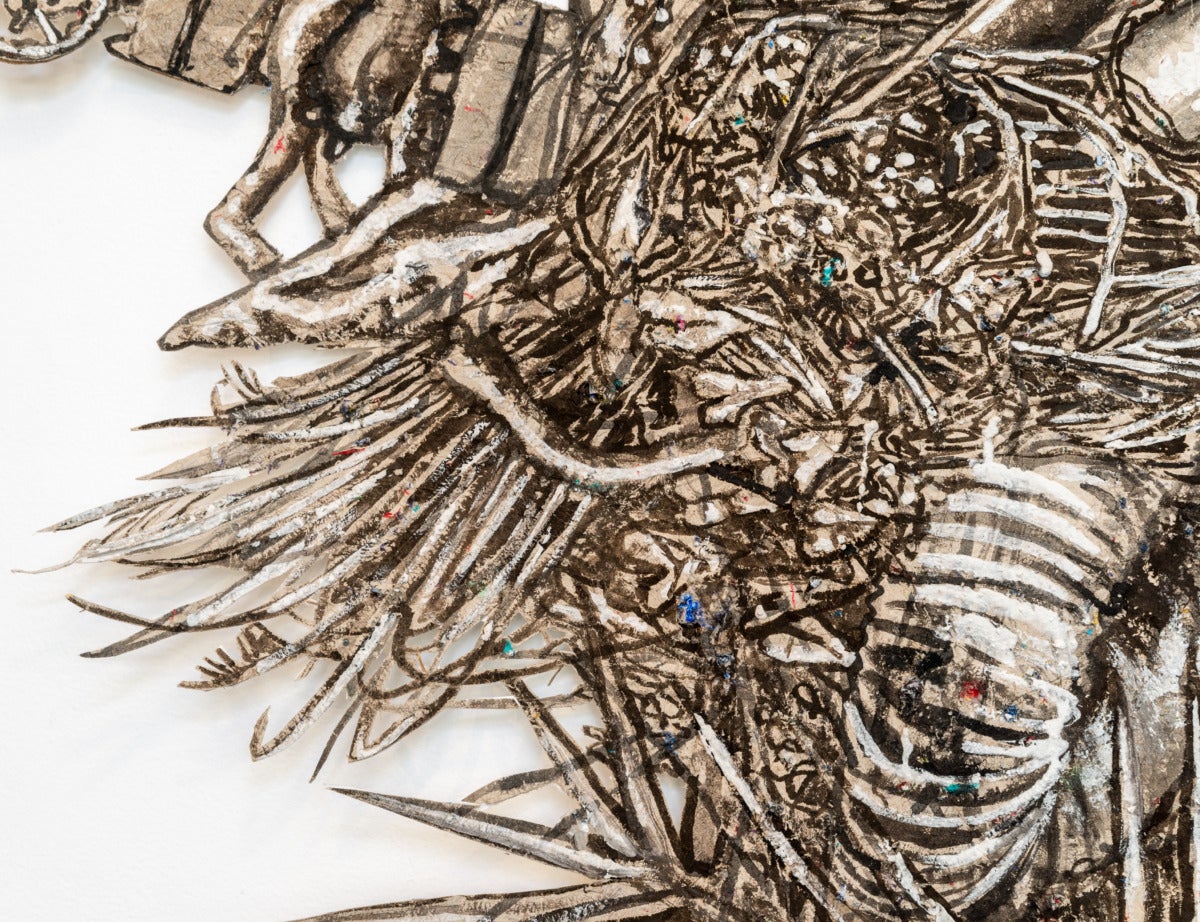
AY: There’s also a sense of being trapped between the history of Louisiana (its agriculture, industry, and structural disenfranchisement) and that uncertain future. Your work, for me, mediates between past and future in a fascinating way. You make use of objects and materials that have their own potent histories, but you also consider your work to be reflective of possible ecological futures. How might you describe that aspect of your work?
HC: I think about the drawings and sculptures as ecosystems that our children might inherit, or what we will leave behind if we don’t hold these industries accountable—whether or not humans are still on the planet at all! At a time when South Louisiana becomes uninhabitable for people, maybe plants will still be able to thrive here, or even colonize our detritus. I think a lot about industry, and everything we’ll leave behind, and I imagine that maybe new land will form over it. It’s dystopian, but I suppose, using the actual living plants, I feel somewhat hopeful. There might be life. I’m wanting to use that beauty to draw people in.
AY: When did you start using live plants in your work?
HC: I started around 2009, when I moved back to New Orleans for the first time since Hurricane Katrina, and I was responding to seeing abandoned places, or places that had been neglected, becoming new ecosystems. I started to use plants in installations, but it’s more recent that I’ve integrated them into the actual drawings and forms, just since the pandemic. It’s been an exciting evolution for me, integrating plants into sculptures—which I think of more as sculptural drawings.
AY: I’m really interested in the large drawing, Petroplexus. It’s enormous but also fragmented—the outline and surface are uneven and very topographical. I would love to hear you speak more about this piece and the experience that inspired its composition.
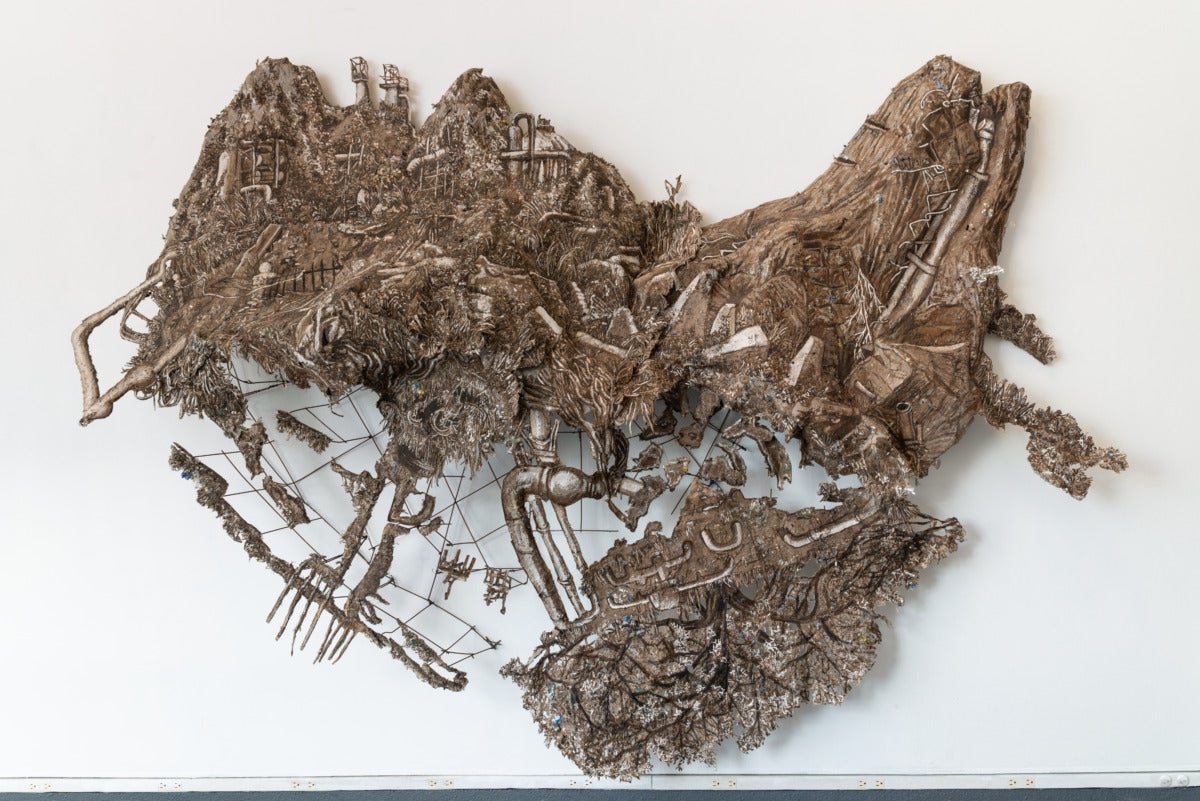
HC: I love that topographic way of describing it. Yeah—this piece was inspired by a flight I took with Southwings, an organization of volunteer pilots who do environmental conservation work. I pitched to them, as an artist who really wanted to see the coastline from above. I was able to go with another artist, Ana Hernandez, and it was amazing; as soon as you get up in the air from New Orleans, it’s basically water. I’ve seen the maps of walkable land in Louisiana, but seeing this fragmentation with your own eyes is pretty crazy. You understand the risk, the precarity, how the land is broken up, and the geometry of the oil industry, the scars of the dredging. The levees on the river. There are many reasons why the coastline is eroding, and it was fascinating to see with my own eyes.
AY: To create drawings like this, you have been experimenting with different materials from which you can derive the ink, right?
HC: The iron oak gall ink, I’ve been making for a while. When a wasp lays its egg on an oak tree, the tree responds by growing a gall that the wasp pupates in, and then once it is grown, the wasp crawls out and leaves behind that form on the tree. Oak galls have tannins in them, and that’s what makes the dark ink. So you can collect them off the trees, and grind them, and add iron to create ink. At first it looks black and then it fades to a sepia. Oak trees are also a huge part of this landscape. They can live hundreds of years, and in that sense are older than colonization. I think about the history that an oak tree has seen, what has happened in that time frame. The white ink is made from chalk. And the newest black ink is from the pollution of coal export facilities. So, I was working with an activist in Cancer Alley who helped me to identify sites of pollution and to learn more about this history. We drove through Cancer Alley and when we found these sites, I would scurry out and collected the coal mud! And then I ground it down and made a pigment. That’s basically what carbon ink is. I imagine that all materials are waste materials, in a way, so I’m just reframing pollution as an art material.
AY: I never realized this about carbon ink! And sugarcane was also a material used in papermaking in the nineteenth century, in the South, right? What seem like unconventional uses of found materials in your practice often do, in fact, have a similar historic usage before the arrival of contemporary industry.
HC: Yeah, it’s a way of recovering all of this lost knowledge. I also think of this as a way to be more connected with the land and the landscape. It becomes more possible to exploit the landscape if you don’t form a relationship with it.

This essay is part of our yearlong series Invasive Species.
Find out more about the three themes guiding the magazine’s publishing activities for the remainder of 2022 here.

